Watching “old guys” playing with Linux on YouTube
Since the pandemic, I noticed more and more YouTube channels of people likely to be 50+, 60+, or even older, who rant about Linux (not all the time, but still). I didn’t want to write about them, but now there’s I reason why I’m doing it.
What kind of guys?
OldTechBloke (Steve Anelay from Manchester): what could be his age? How about this guy? Jack Keifer must be antediluvian, yet he’s playing with Linux! Christopher Barnatt is much younger at 54. Ermanno Ferrari is even younger, probably 51, but he got RHCE after a life of a musician!
But the latest discovery is Station Sixtyseven (possibly a certain Nigel North, Kettering, UK, but not the one having a Wikipedia page!) which I guess means “born in 1967” (it matches the person seen in the videos). And there’s one special thing about this guy: take a look at his album “33 poems” (sort of an audiobook, posted as a music album); the Introduction starts as follows:
This is the output of somebody who is lost in the present, desperately wishing to go back to the past, and terrified of the future. This is England condensed, as I see it in the 21st century.
Wow. I can definitely relate to that. So I decided to watch his videos, and the videos of other such people, to see what kind of Linux distro they like, and why.
There is a big void . . . and some derivatives
I noticed Station Sixtyseven seems to like Void Linux, and then a derivative (or a respin) of it called AgarimOS. OldTechBloke also examined Void Linux in June 2020, but Station Sixtyseven has many videos about it.
The problem with Void Linux is not that’s an independent distro, with yet another unique packaging system, and a strange love for musl. They also build against glibc, and their documentation is rather good.
The first of their problem is that one cannot trust a distro that, mid-May, links all the current ISOs to the February builds, not to the mid-March ones. That’s related to the fact that on March 16 they started to build the ISOs… and stopped before having built all of them! The February builds are complete, but the March ones only offer the base, cinnamon, lxde and xfce (all in both musl and glibc variants), but no enlightement, lxqt, or mate. They couldn’t be bothered to finish the process. Will they ever? How professional is that looking to you?
An even more bothersome problem is their approach of communicating with their user base. I’ve seen distros made by 2-3 people, and even some one-man distros who bothered to set up a forum. Any serious distro has a forum, even the derivative ones; but this is an independent distro (13 developers, currently!), not a derivative, and yet, they can be reached only:
- On Freenode. Heck, only nerds are using IRC these days! (OK, the Linux kernel guys are also on IRC, but how many Linux users want to interact with the kernel developers and maintainers?)
- On Twitter, which is hardly appropriate for that.
- On GitHub, where it’s difficult to understand on which of their projects you might want to open an issue, should you find a bug.
- On Reddit, for which the corresponding channel is not mentioned on their website, but only on Distrowatch, under “related websites”! Not to mention that Reddit is a glorified 9GAG for most of it, and even when used as a forum, the posts are sorted by a mix of “likes” and date instead of being grouped thematically and chronologically, so basically it’s unusable; the only way to find something useful on a distro’s Reddit channel is when a search engine directs you to a question or to an answer.
After having interacted with them on Twitter, they bothered to answer with this tweet, but of course NOT ALL of the links are on their website, especially not the Reddit one!
The official channels of VoidLinux are:
— VoidLinux (@VoidLinux) May 14, 2021
* https://t.co/4tW6JpinYz
* ircs://irc.freenode.net/#voidlinux
* https://t.co/C7E71LckQc
* https://t.co/UbcQUYgYQx, especially https://t.co/ogwxyv9mRl
All of the links can be found on the main page of https://t.co/698xt7jMI7: pic.twitter.com/1tcKo9zFw1
Things have quickly degenerated, showing me that they don’t want new users, and they don’t want to have a community (Reddit is a random herd, not a community; forums and mailing lists make a community):
You don’t decide for us what the right thing to do is. We want bug reports in the bug tracker. The reddit exists purely for the reason that we don’t want to host extra useless forum software.
— Duncan (@duncaen) May 14, 2021
If you don’t like how void communicates, maybe don’t use it? Alternatively, stop caring.
— Michael Eisemann (@MEisemann) May 14, 2021
Feel free to call the manager.
— VoidLinux (@VoidLinux) May 14, 2021
well then, piss off
— Daniel Kolesa (@octaforge) May 14, 2021
consider this: we don’t owe you shit, and if you don’t like it you can always go elsewhere, if you’re so incapable of not being a massive twat
— Daniel Kolesa (@octaforge) May 14, 2021
it’s always funny how randos seem to be under the impression that their outside opinion matters in a FOSS project, going to great lengths to present it in as douchey manner as possible
— Daniel Kolesa (@octaforge) May 14, 2021
Of all, Duncan blocked me. The Czech guy is too arrogant to even care. Funny thing, someone on Reddit praised Void’s virtues, including…
-Friendly, expert, helpful and resilient community.
Now, if we were to examine the March build of Void Linux, in its Cinnamon (and glibc) flavor, it’s not that bad, except for two things: first, it doesn’t come with OctoXBPS (the GUI-based package manager), so I had to look up how to install a screenshot app:
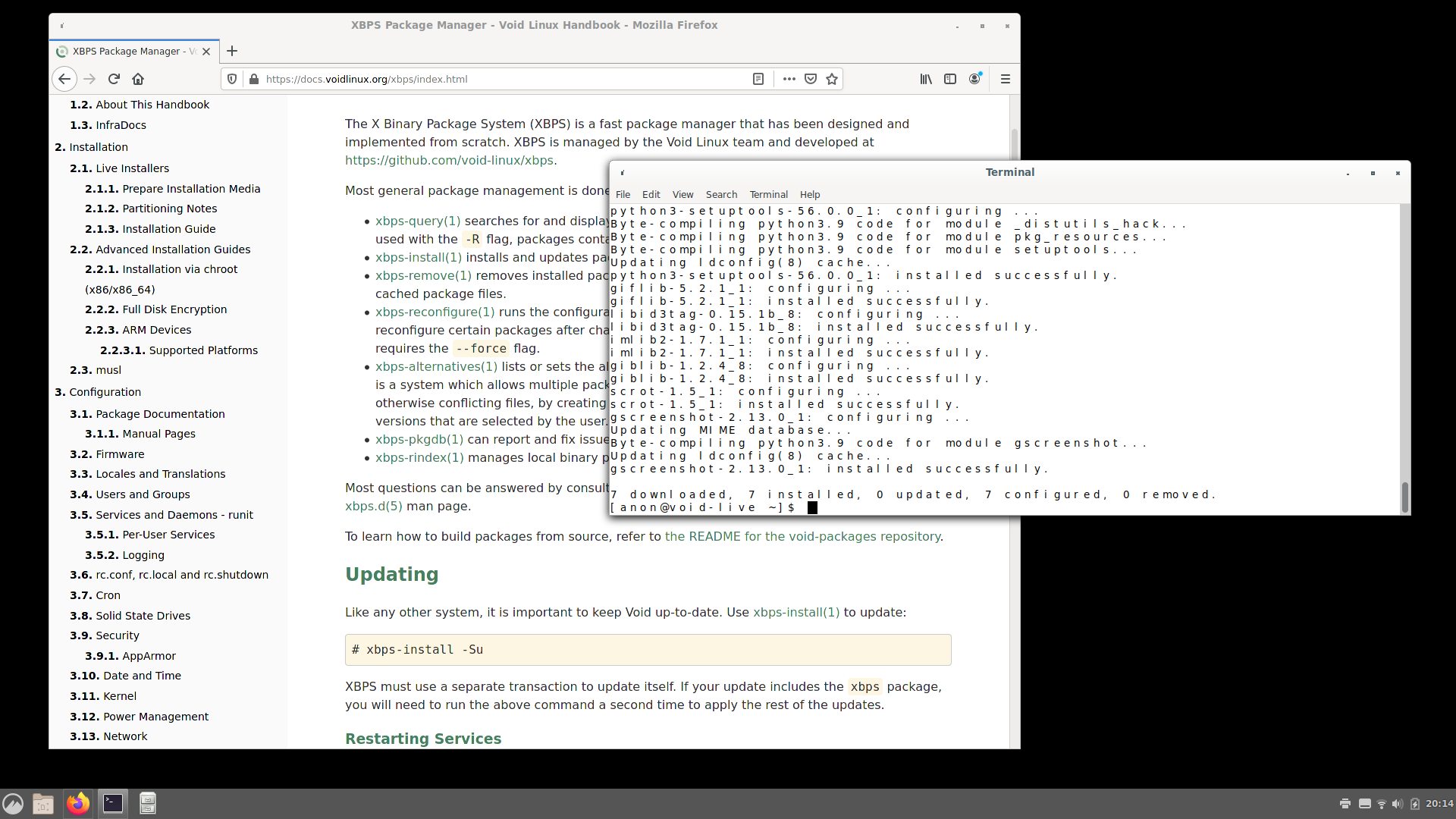
Secondly, while uncustomized, “pure” as per upstream packages are normal in a “base” (i.e. non-derivative) distro, the terminal simply uses an impossibly spaced typeface:
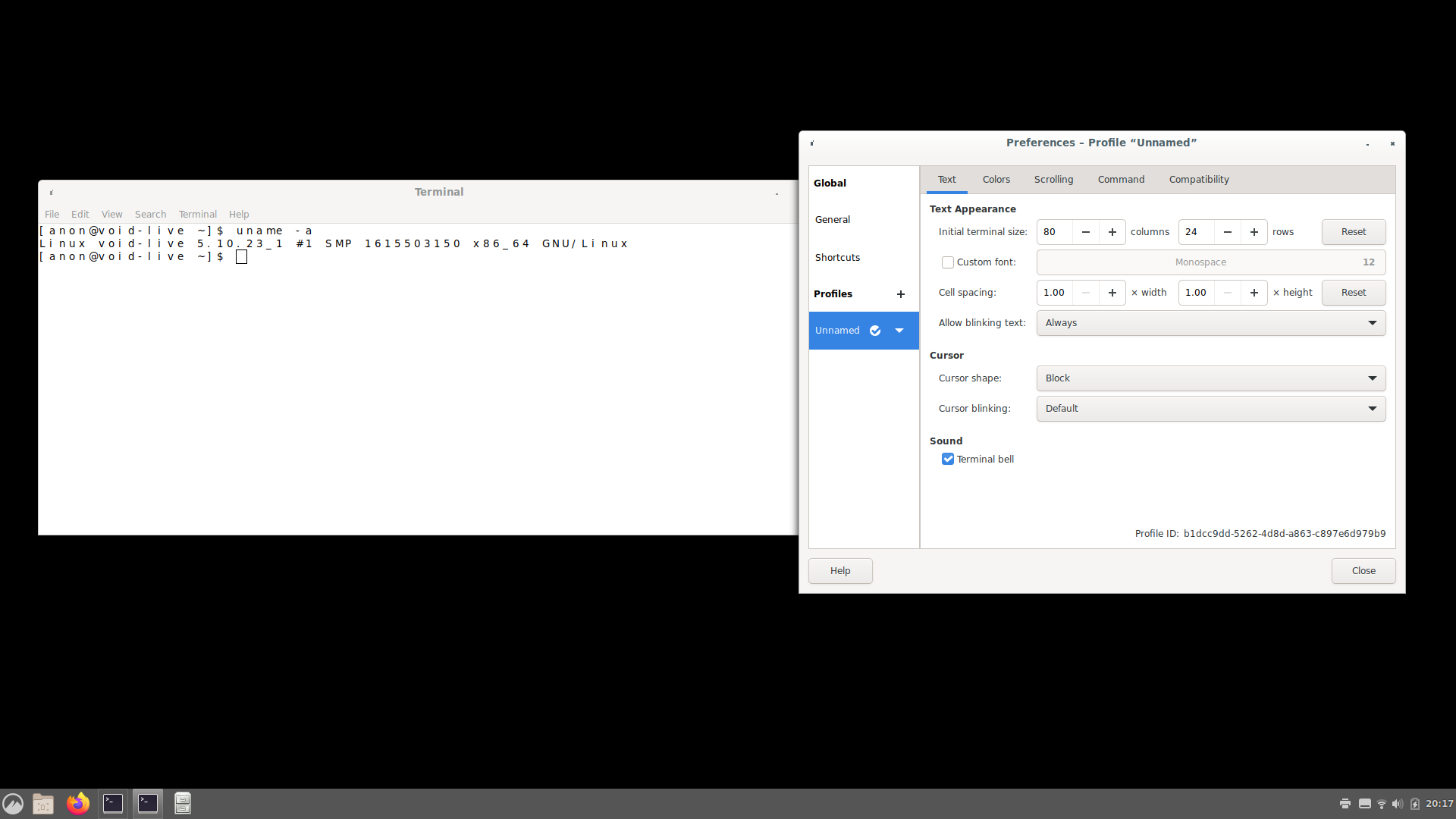
However, by just clicking on “Custom font”…
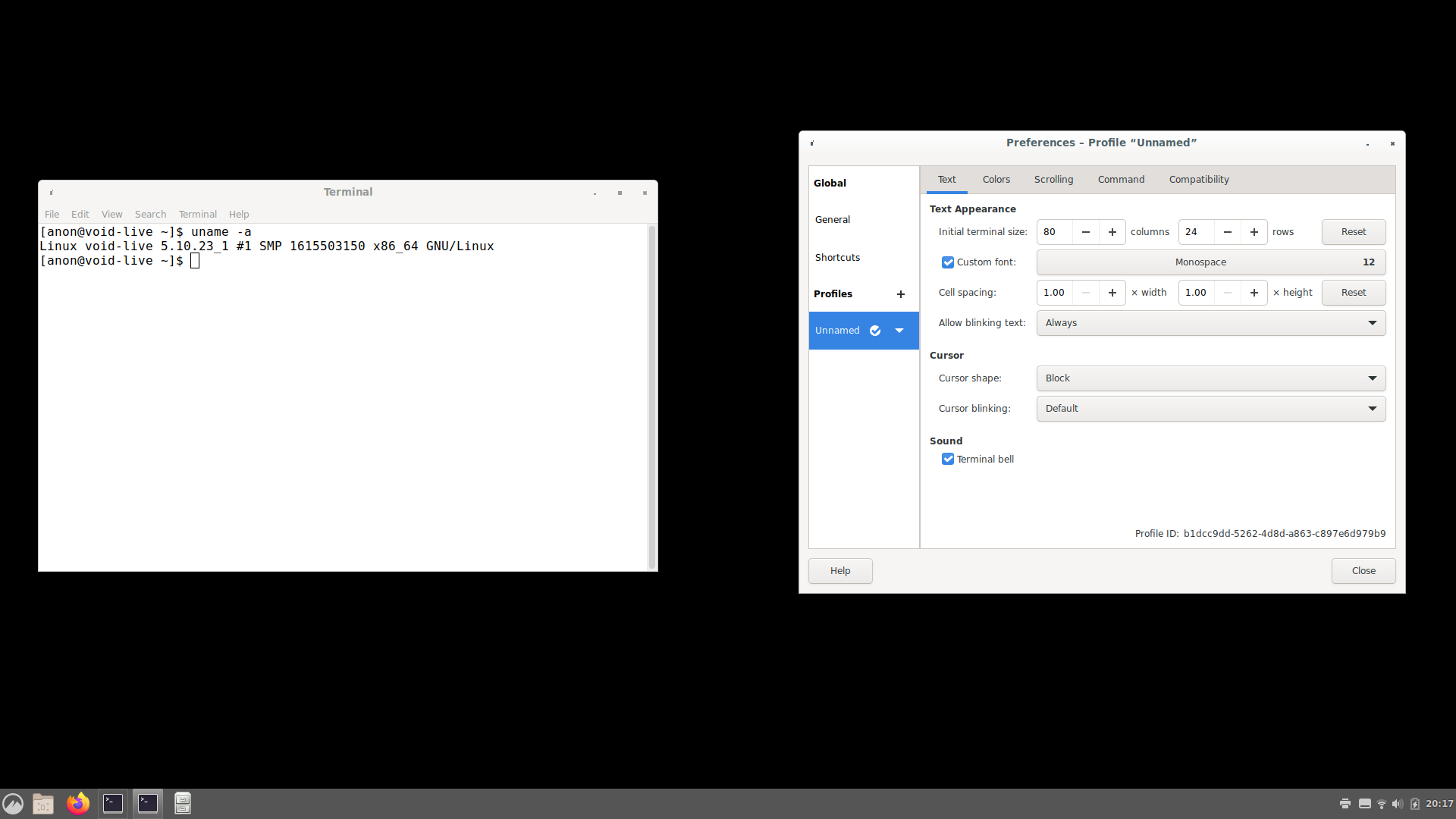
A much younger guy, Tyler’s Tech, in his May 19, 2020, Installation and First Impressions of Void Linux Cinnamon, was as idiot as to install and use it without being bothered by the unusable font, and without touching any settings! And he’s supposed to be a distro tester and an influencer and a fucking owner of a popular YT channel?!
Now, much more pleasant would be to use one of José Santos’s projects, namely AgarimOS, which is a respin of Void with a large choice of Desktop Environments. From what I tried, the customizations are modest, but at least OctoXBPS is always present.
In MATE, the terminal isn’t really legible:
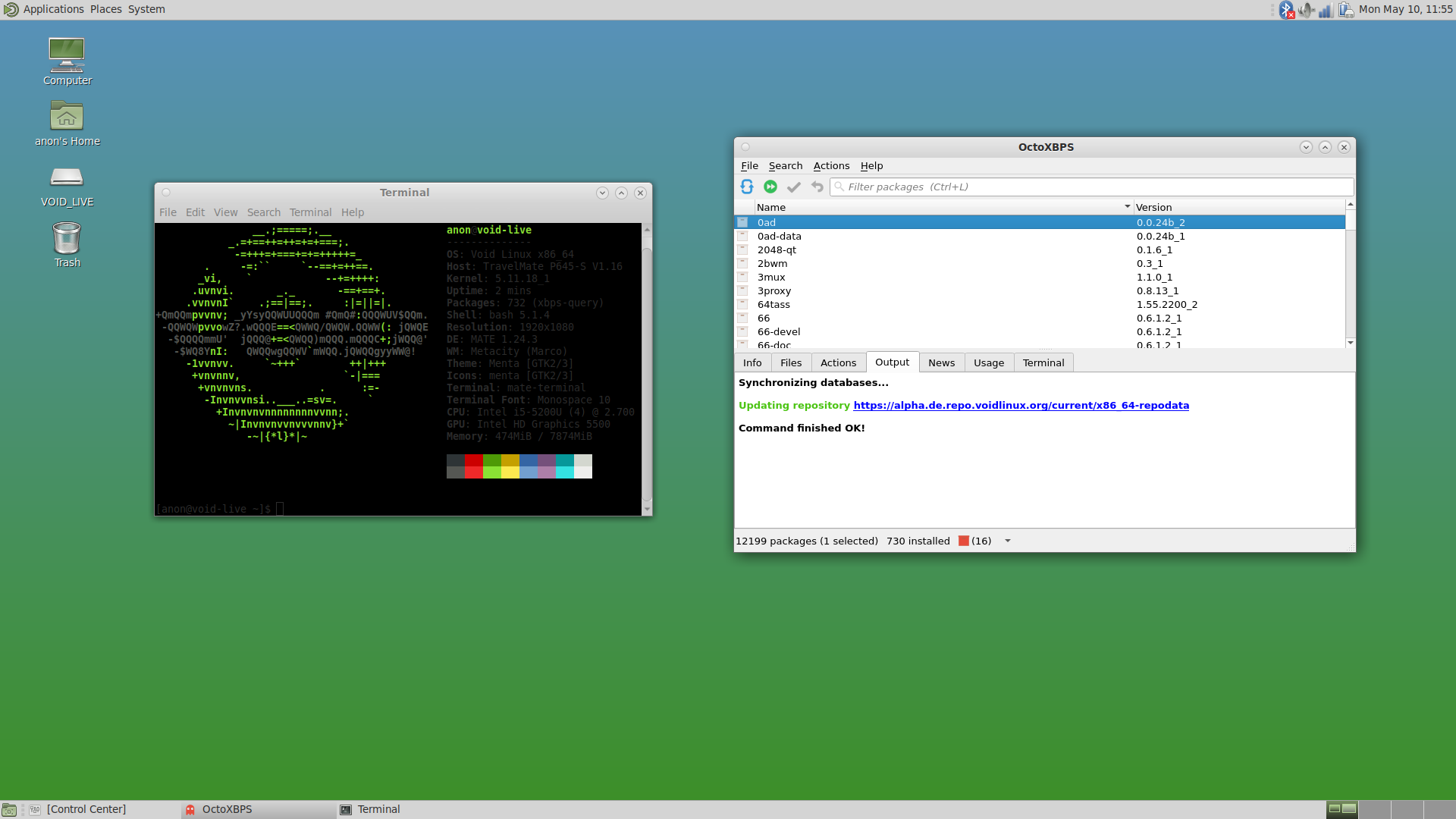
In XFCE-ECE, the system is in Spanish, and Tilix is using the same impossible font:
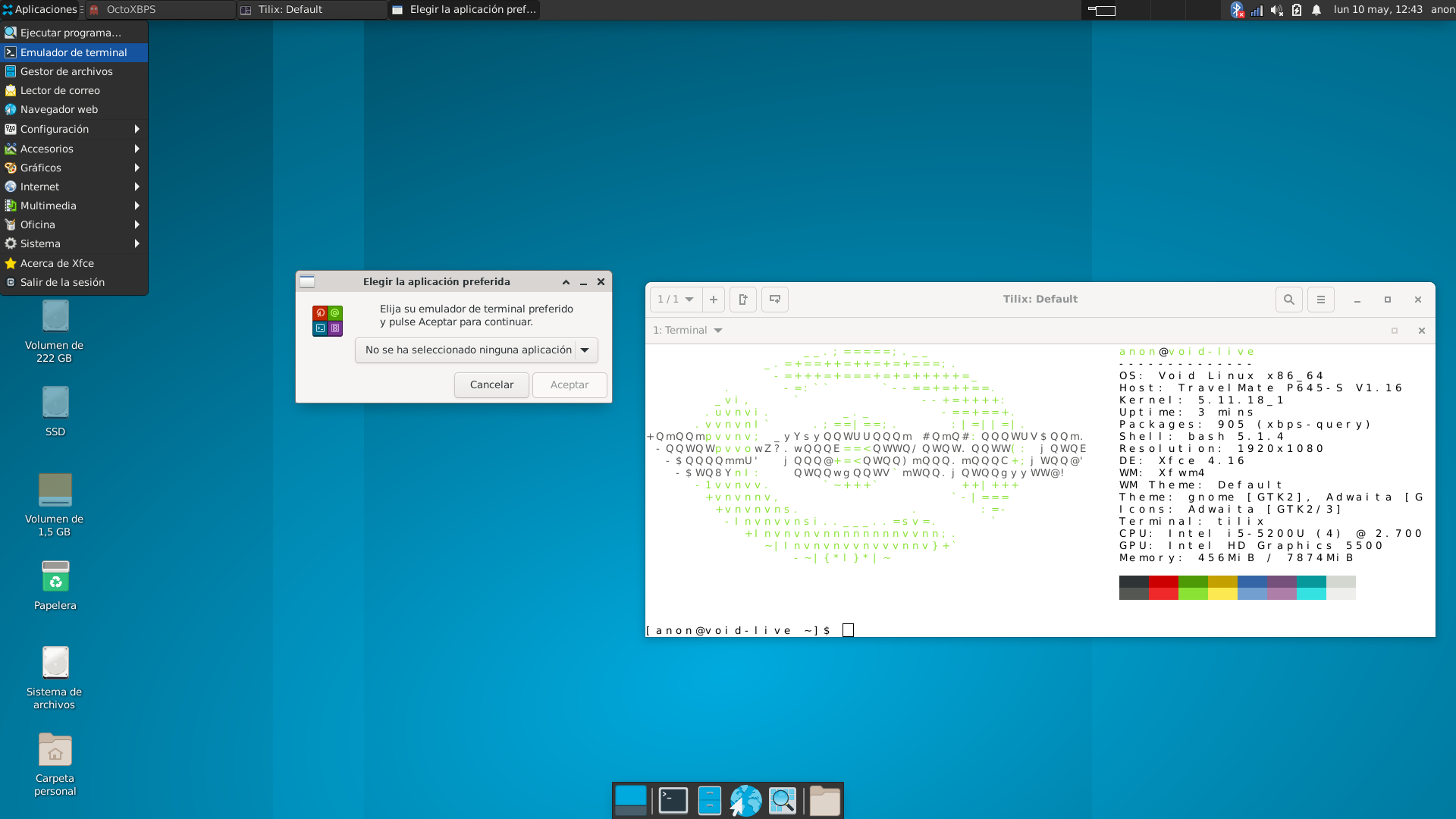
KDE is better:
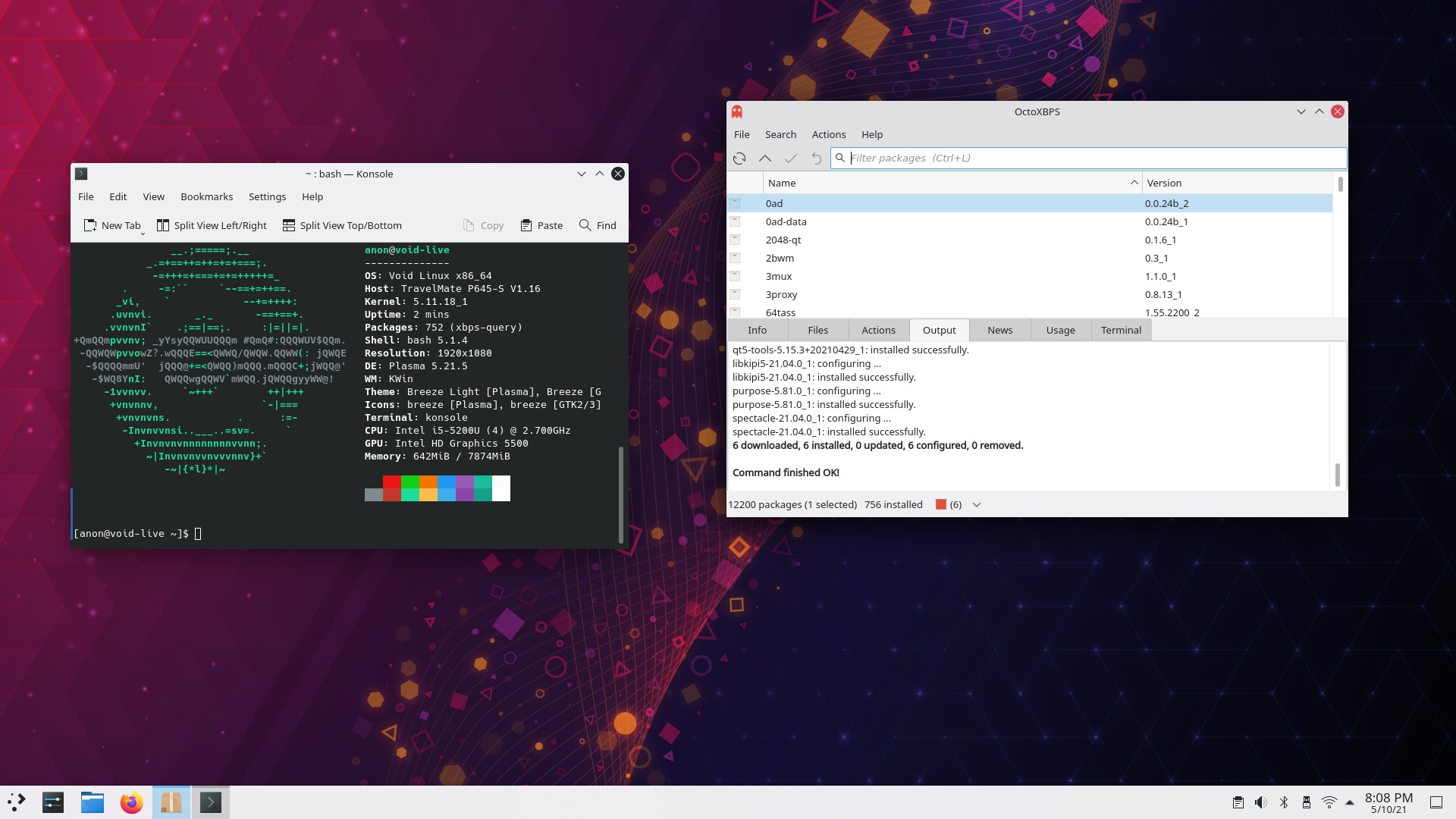
An important note: should you want to change the system language in MATE (in AgarimOS or in Void itself), it’s not that easy, as the Control Center doesn’t help you:
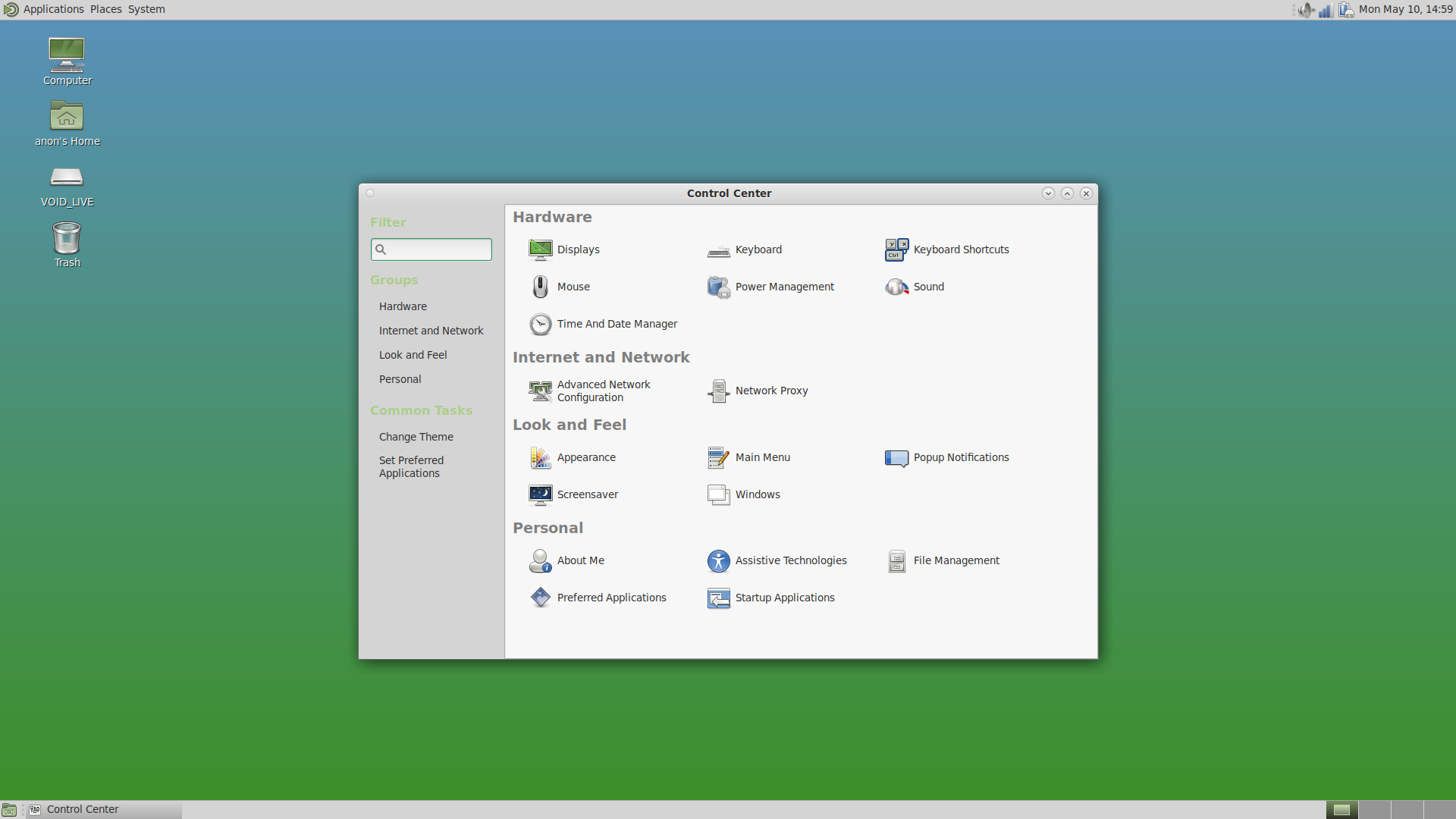
The complete Control Center should help with internationalization, as it’s the case in Ubuntu MATE:
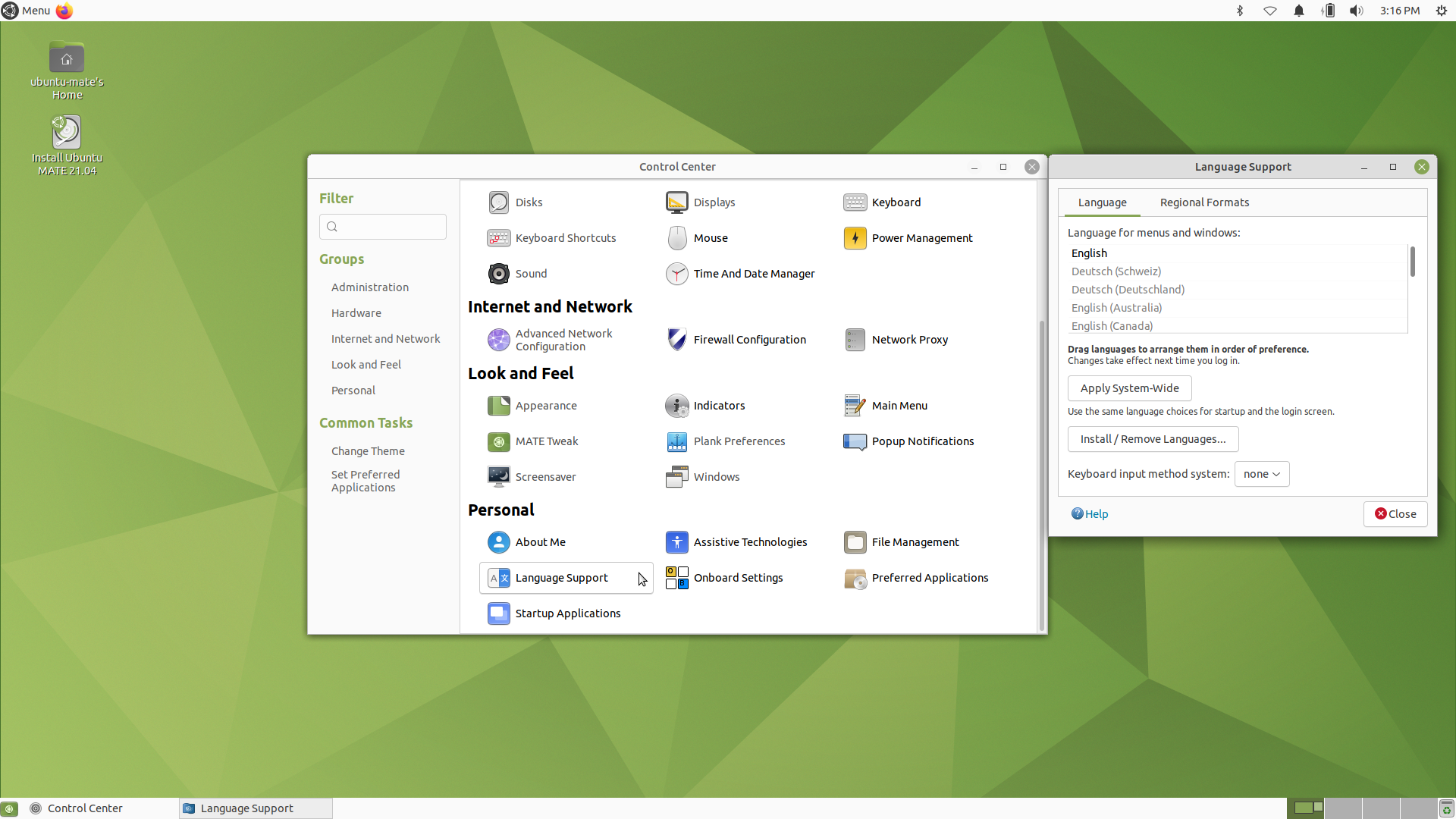
LATE EDIT: The Language Support feature in Ubuntu MATE is gnome-language-selector offered by the language-selector-gnome package (the name inversion is caused by the fact that it replaces language-selector), which doesn’t have any GNOME dependencies, but only GTK3:
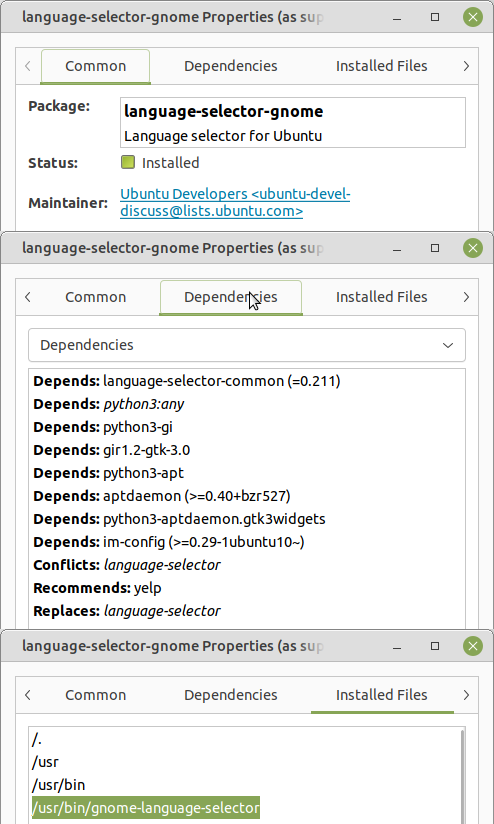
I don’t quite understand Station Sixtyseven‘s love for Void and AgarimOS. Certainly, they’re not bad, and those 12k packages include almost everything one might want, but still… Oh, OldTechBloke also was Stepping into the Void (Linux): A Fast, Minimal and Independent Distro last summer. Nothing too persuasive.
Oh, I was forgetting: LXDE is terribly ugly in both Void and AgarimOS, and the March build of Void Cinnamon couldn’t mount any drive, so when it booted it cycled indefinitely like so:

Real tests are always done on bare metal, not in a virtual machine. In a virtual machine, 100% of the hardware is supported, there’s wired Ethernet, and so on.
A different visit to the past: do you like owls?
The rediscovering of memories of dead Linux distros reminded me of a nice distro I kind of liked for a short while: UHU-Linux, discontinued at some point after version 3, for unknown reasons.
What I hate is when a distro seems dead, but it’s not. Most frequently, they stop releasing ISOs, but the packages seem to continue to be updated. No matter they’re marked as “dormant” or as “discontinued” on Distrowatch, they’re zombies! Less zombie than those that are really dead but their websites are still up, though. Here are a few examples of “revenants”:
- Chakra Linux: last ISO from 2017-10, but there’s still activity in their forum.
- Frugalware Linux: last ISO from 2016-04, but packages seem to be updated by some God; i.e. this one is from today!
- Lunar Linux: not fully dormant, despite the website being frozen as of Oct. 17, 2017; daily ISO builds are here!
- UHU-Linux, which we’ll discuss below.
UHU’s website still lists version 3 from 2014, labeled “LTS” afterwards. Kernel 3.15, can you imagine that? If you click on Community (in Hungarian), you’ll find about UBK.HU, “The UHU-Linux Friends page,” which would point you to the ISO download page, containing UHU-Linux-UBK4-MATE builds from March 2021, UHU-Linux-UBK5-MATE test builds from May 2021! They feature some 4,100 packages.
We’re not in the old good times: it’s not Hungarian or English, but Hungarian only, and no way to change it:
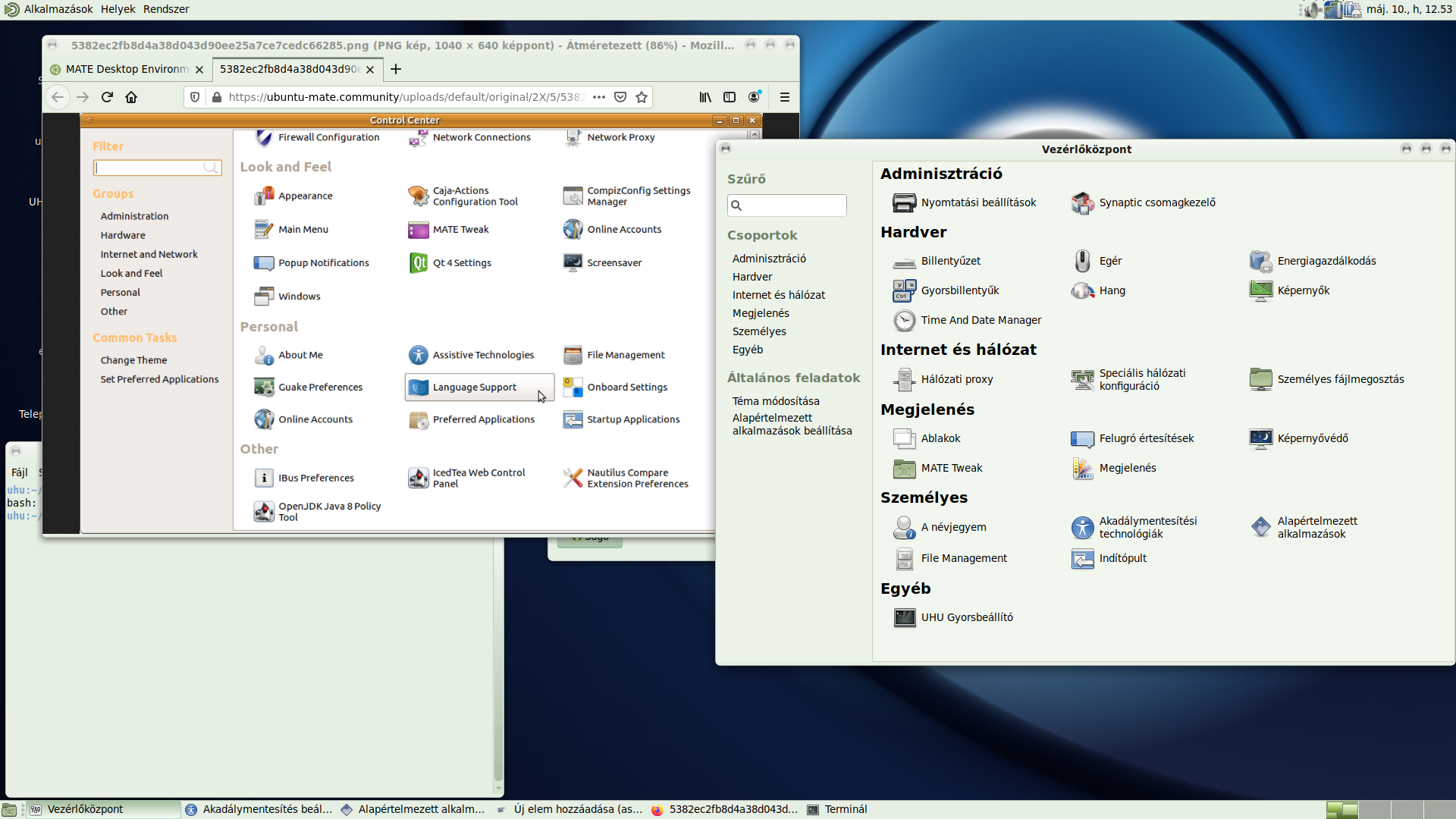
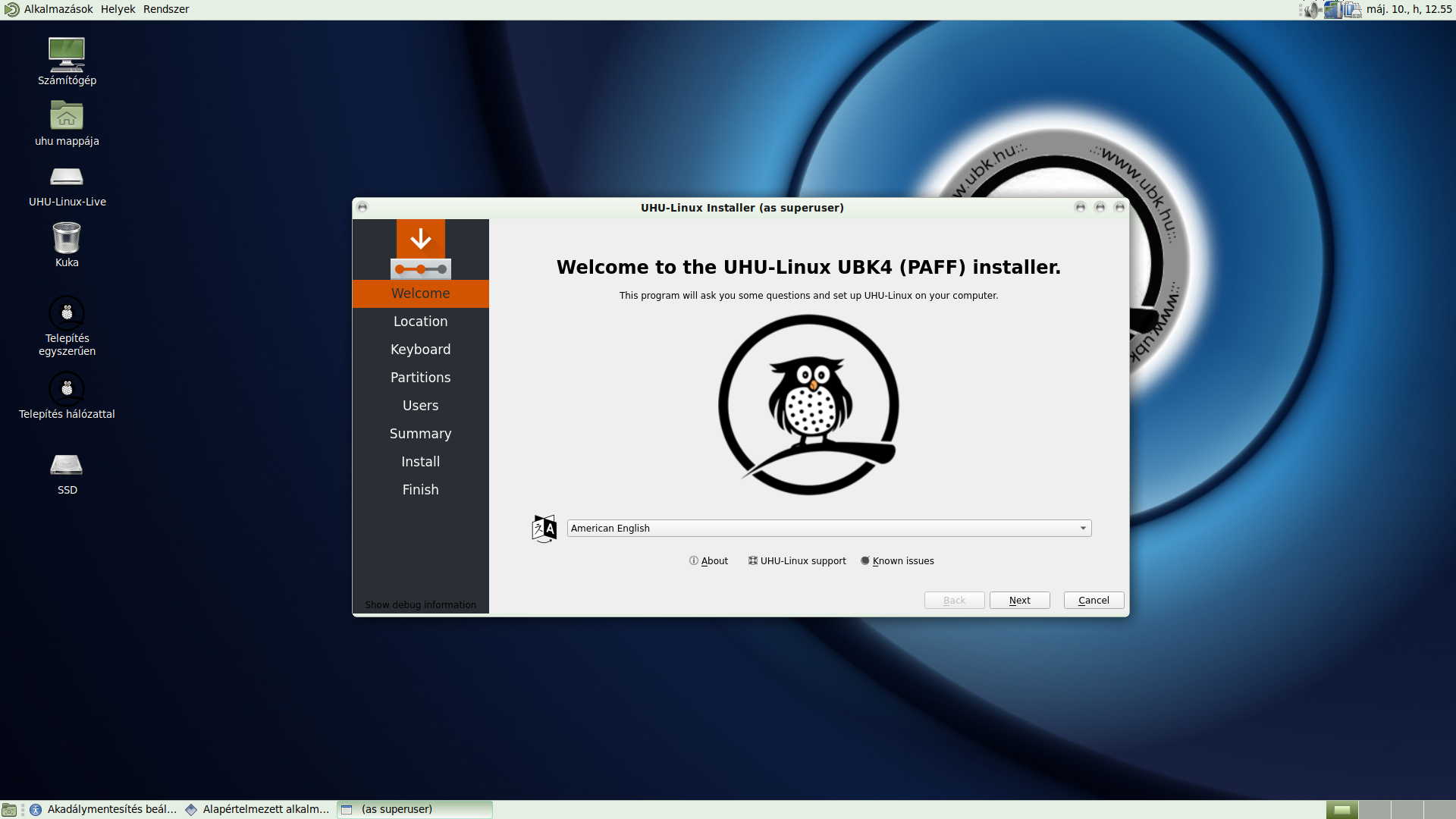
And UBK5 (test build, OK?) freezes after having started X. Too bad.
Back to my “old people”
On Station Sixtyseven‘s YT channel, I noticed Simply Linux 9.1 ~ from ALT Linux. The problem with the various ALT Linux flavors is that the whole thing is a mess. The website in English is a joke. The latest releases of ALT Workstation 9.1, ALT Server 9.1, and ALT Education 9.1 are from August 2020, and they include MATE 1.22.2, but also XFCE 4.14.2, KDE 5.18.5. Better D/L speeds can be obtained from distrib-coffee.ipsl.jussieu.fr, which reveals that the ISOs were released end-July 2020. But 4.7 GB for a workstation ISO is too much!
The “Simply Linux 9.1” version of ALT Linux can be found here or here, released on April 28, 2021, and its size is decent at 1.7 GB. Unfortunately, even updating the packages, you won’t get XFCE 4.16!
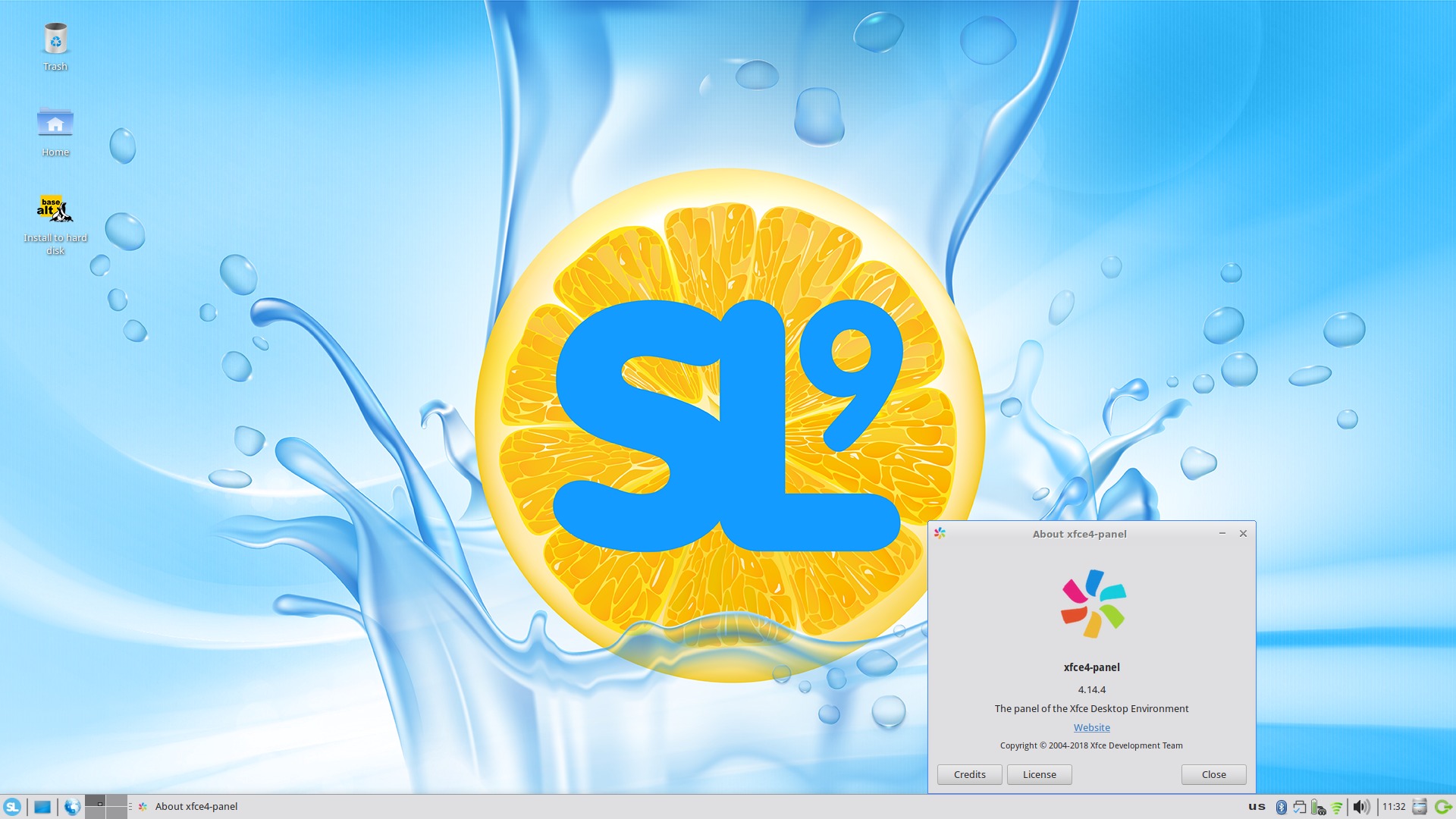
It’s funny how it looks more like KDE3, but most people won’t get charmed, I reckon.
To get the newest packages, one would have to use Sisyphus, which is something like Rawhide/Cauldron/Cooker/Tumbleweed/Current/Unstable in other distros. The very latest ISO builds are in nightly.altlinux.org/sisyphus/current/ (which I suppose means “unstable”), but I preferred nightly.altlinux.org/sisyphus/tested/ (tested means tested, huh?), namely regular-mate-latest-x86_64.iso. Not really nightly or daily builds any of them.
Well, fonts are huge, because the DPI was automatically set to 158, for some unexplainable reason:

46,000 packages! Not bad…

Let’s install something from their repos, say Foliate. Ouch, it has the same bug as Void had last year, namely it doesn’t make a link or an alias to the binary, which is called com.github.johnfactotum.Foliate. Running it by the full name made it crash:
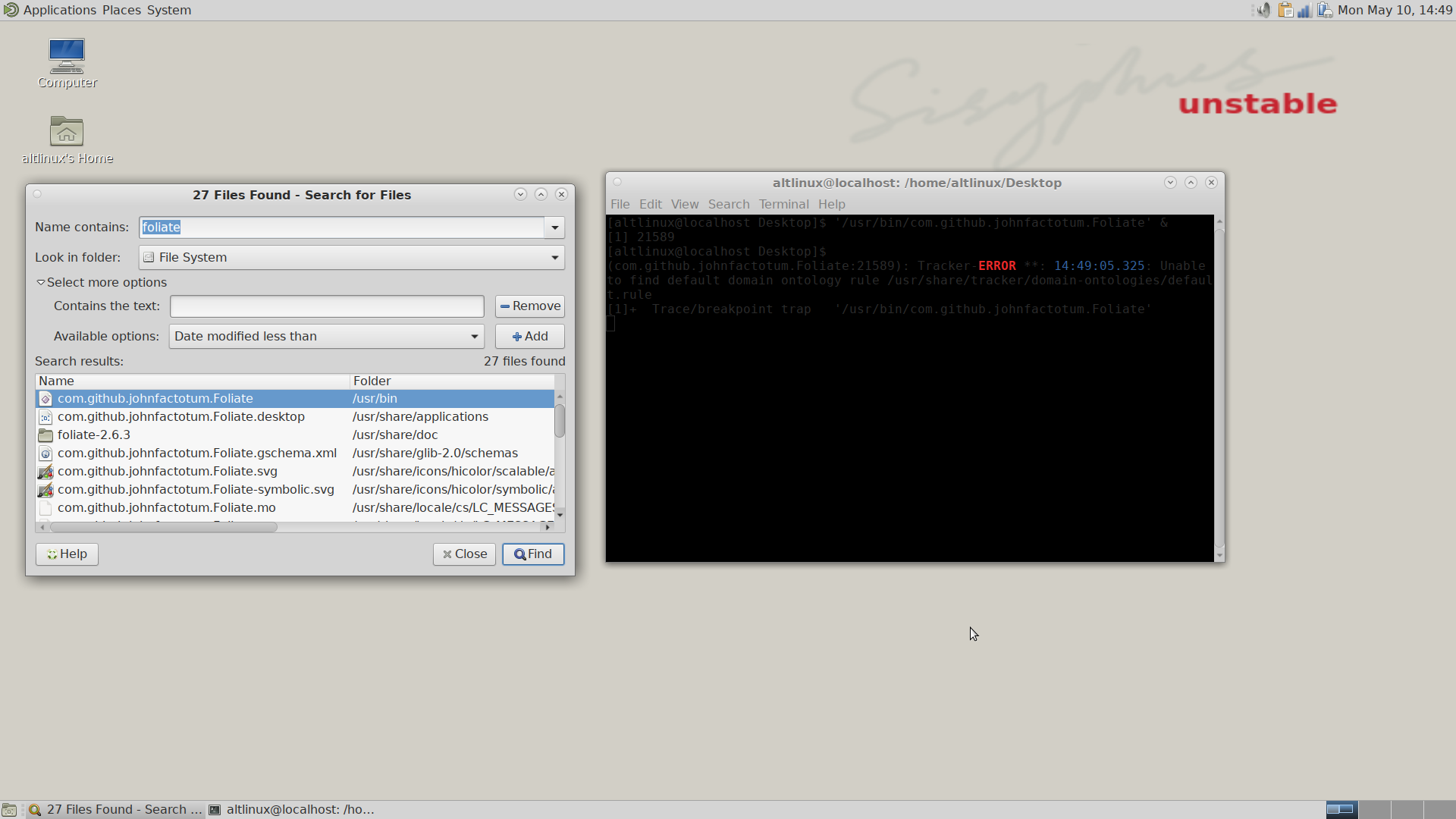
What is wrong with anyone who sets the terminal text in dark gray on black?!?
A random bad word about Bodhi Linux 6.0.0. I can’t understand how could people like this strange fork of Enlightenment that needed more than one full year to jump from being based on Ubuntu 18.04 LTS to being based on Ubuntu 20.04 LTS! Also, I like green, I like nature, and I like earth colors/tones/palettes/color schemes. However, Bodhi looks rather childish and unpolished to me.
In truth, Bodhi’s main developer, Robert Wiley (in his own words, “a somewhat sick 60 some year old brick mason”), had a severe COVID-19 case involving two hospitalizations, while he also has asthma. Well, then here’s a distro by old people, for old people.
Station Sixtyseven liked it. Jim Acklaw (age unknown) liked it too, then liked it even more. To me, it looks like shit.
UPDATE ON BODHI: I know it’s rude to “cancel” (à la “cancel culture”) Bodhi Linux that bluntly. But tale a look at the reader comments on the announcement of Bodhi 5.0 on OMG! Ubuntu!: beyond those who liked it, there are them:
komorebi • KDE with disabled effects is faster.
hoek • Long story short: it is ugly 🙂
Brad da Silva • Jesus Christ, my eyes.
Carlos Felipe Araújo • Very ugly, especially the icons.
masterius • I don’t mean to be rude, but I have to agree. It conceivably lacks some basic design principles such as balance, alignment, or proportion. Just take a look at that notification gadget and you’ll see what I mean.
Freddi • I agree regarding the lack of padding around the oversized panel icons.
In 2001, Dedoimedo was finding the incipient Bodhi Linux minimalistic and pointless. In 2013, Bodhi Linux 2.2 was square peg for round hole. Finally, in 2017 Dedoimedo interviewed the Bodhi Linux team, but meanwhile the team shrank considerably, first by losing Jeff Hoogland. The interview mentions 8 guys, but currently, the distro only has 2 developers.
Last but not least, OldTechBloke has revisited Salient OS, and he’s all positive, as expected. What he couldn’t fucking notice, because he always installs in a virtual machine, is that the May build of Salient OS failed to include NetworkManager (as I mentioned here), which makes it difficult to enable the WiFi the easy way. As I said then and there, I guess it wasn’t wise to trust Salient OS that much. Once again, the only real tests are on bare metal, unless the respective distro is meant to be used in a container.
UPDATE: The initial May XFCE and KDE builds of Salient OS, from the folder 2021-05 and dated May 6, have regressions and bugs like the one mentioned above. Silent Robot has fixed them in the builds from the folder 2021-05-1, dated May 9 and May 10. The good news is that the ISOs have been fixed quickly. The bad news is that the fixed ISOs have exactly the same name as the old ones, and that the folder with the defective ones is still there.
MATE all over the place!
End-November 2020, in response to Ubuntu Mate Still A Linux Gold Standard, Station Sixtyseven posted IS Ubuntu MATE still the ‘Gold Standard’? Ubuntu MATE 16.04 LTS might have been “solid gold” (except possibly for its wallpapers), but did things really get worse nowadays? Not that much, he admitted.
The good thing in Ubuntu MATE 20.10 was that the only preinstalled snapd packages were software-boutique and ubuntu-mate-welcome. In 21.04, as we saw here (towards the end), also gtk-theme-yaru-mate and icon-theme-yaru-mate come as snaps.
I asked him to take a look at the latest release, and he did: Ubuntu MATE 21.04 ~ A look around… Unfortunately, he’s a bad reviewer, and I had to comment on his video:
I was expecting much more from you. Sorry, but you don’t know how to test a distro. You should have changed the layout from Familiar to Traditional to get the REALLY traditional GNOME 2.3x menus, i.e. separated into 3 menus (Applications, Places, System) that are non-searchable (not Brisk). MATE Tweak doesn’t give you previews of the 8 different layouts, but the Welcome app does; you decided to skip that one. The snap rubbish is unfortunately real 🙁 The problem is that no other distro has such a good integration of MATE: most other distros have fewer icons in the Control Center (e.g. no Language Support under Personal, for one), and no Yaru-MATE theme(s)!
No commenting back.
Someone called Sloeye trashed this release in a comment:
Not been able to use U.M. for a long time. 16.04 was the best for me. I tried Mate 1.24 in Debian Bullseye. The video playback performance was the worst out all the major desktops. Mate devs need to kill off whatever compositor they are using or fix it. I have also had issues with weird stuff happening from the mate tweak tool. The double icon issue I have read is something called a “race issue”, whatever that is. It has been present in the last few releases for me anyway. That is the brisk menu, It was made by Ikey and the Solus team. It’s far from being anything like the whisker menu other than appearance. Try to customize it. You can’t do anything with it. Linux Mint has always done a far better job with Mate than the people that actually develop it now. I think Clem was one of the original devs that forked it way back when. It would be my favorite desktop if it worked properly.
No, no, no. Marco (the compositor) works fine with Intel video. Brisk can be replaced (there are 8 layouts!), and Mint sucks.
OldTechBloke too tried it: Ubuntu Mate Hirsute Hippo – It Just Gets Better and Better! Well, to be honest, he likes everything (and he talks too much), although these days his comfort zone is in Arch, for it’s a roling release one. However, he says his preferred DE is MATE (when he’s using one).
Funny thing, at minute 20:22 he explores the Color Selection section from the Welcome utility, something I normally ignore, as I just change the appearance from the Control Center. But this one is more like what Mint offers lately (accent colors), which is nice. Old people being old, at 20:55 he failed to apply the desired color scheme, and he clicked the Apply button for the Default scheme, which is why it didn’t change. This is reminiscent of Station Sixtyseven claiming to be using the “traditional GNOME 2.3x layout” when in fact he was using another one.
OK, we, the older guys, we love MATE. How about younger people? Mike from Distrocrunch wrote a review of Ubuntu Mate 21.04, in which he complained of Bluetooth speaker connection issues. No such problem here, where I could easily add and connect mine preferably with the “Bluetooth Devices” utility (“Devices…” from the menu), although it can be done from the “Set Up New Device…” dialog too:
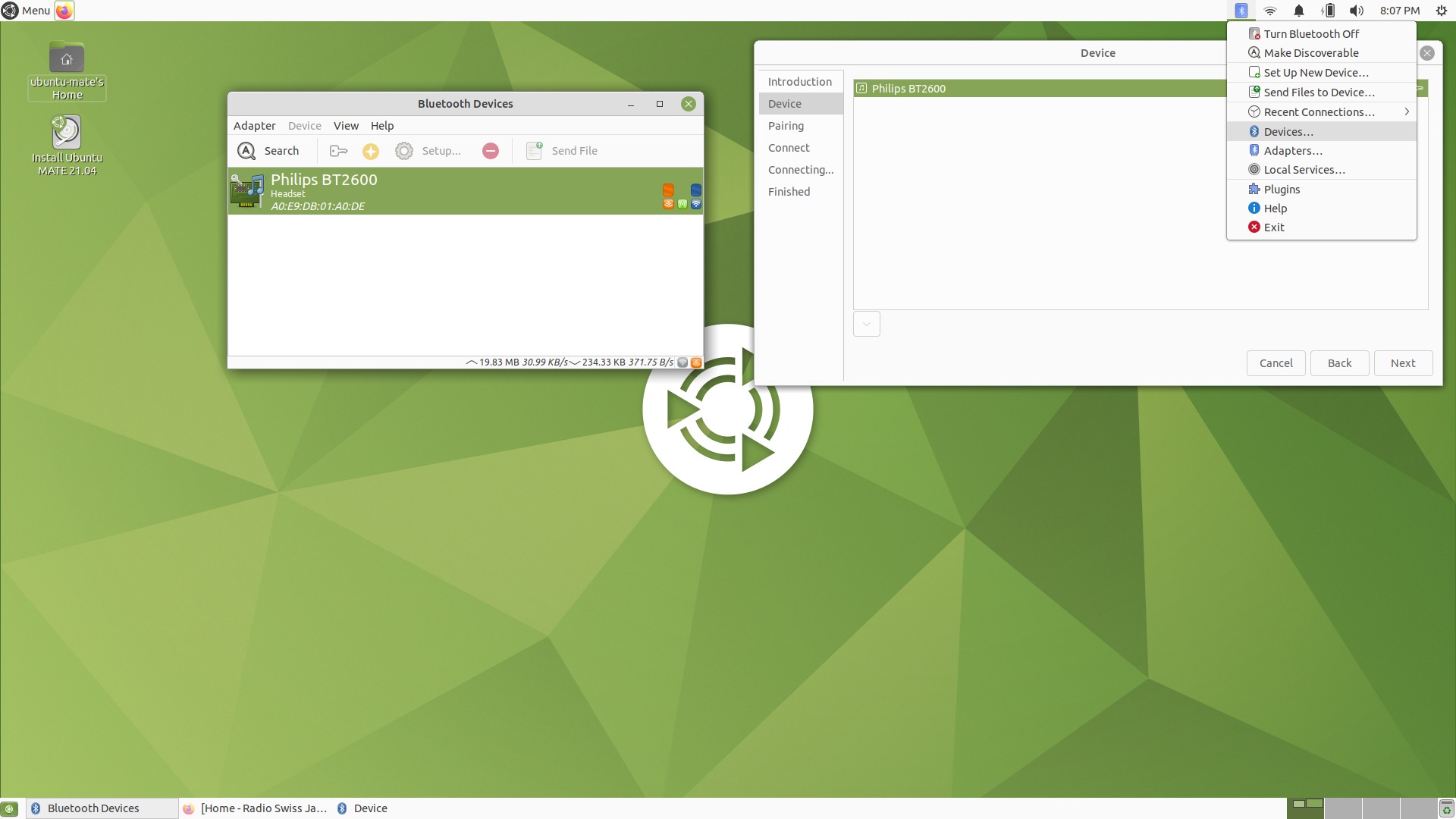
Random tests and notes
SparkyLinux in its semi-rolling edition based on Debian testing, obviously MATE (sparkylinux-2021.03-x86_64-mate.iso). As feared, no support for changing the language in the Control Center, no fancy themes, but quite decent:
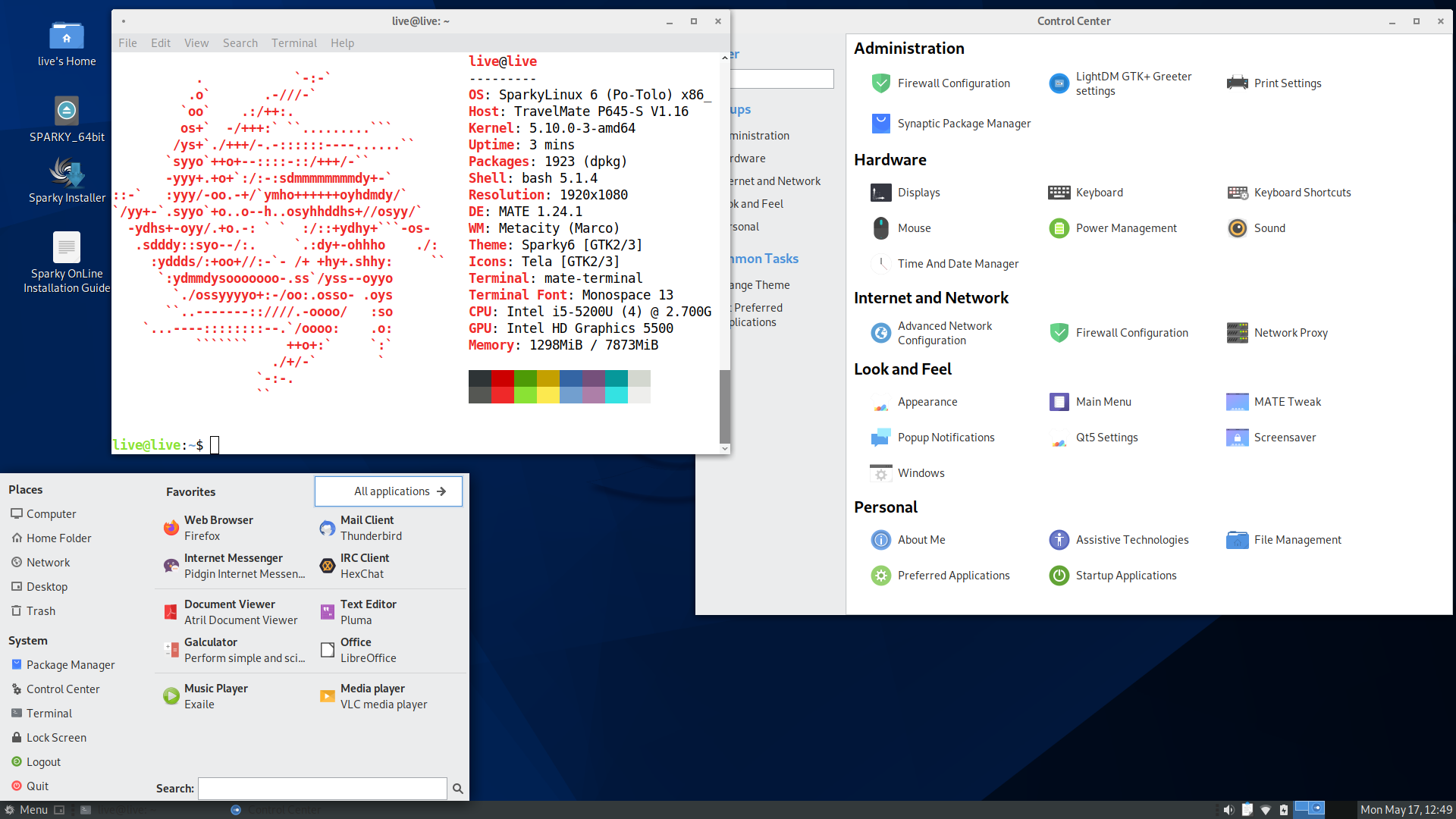
Good contrast in the terminal, but the windows on the taskbar have invisible titles. Are they even testing their shit? Dedoimedo was meaner when he tested sparkylinux-2020.03-x86_64-xfce.iso last year: he complained about everything, including Calamares (which, by the way, still says “SparkyLinux 6 Po Tolo” because it’s the rolling release that will become version 6 when Debian 11 is out), Synaptic (which I love!), and APTus (which sucks).
Here’s a thing: I prefer a stable and predictable desktop environment because an OS is meant to be “transparent” to the user, which should focus on the actual applications. The desktop environment itself should be predictable and ergonomic. I’m sure I’ll die before I could understand things such as:
- How could people use GNOME when huge icons are shown as if on an Android tablet, and when the file manager lacks a compact list mode?
- How could people claim GNOME is the best DE when it needs extensions to make it look decent (including Such Perfection), extensions that always have a timeframe when they don’t work when a new GNOME is released (that’s why many distros ship with 3.38 instead of 4), and how could they find GNOME shell blur helpful?
- Why are people trying to mimic Apple’s left-side window buttons and the bottom dock? I don’t find macOS usable.
- Why is KDE Plasma changing at a rapid pace all the time, sometimes with stupid features, some other times fixing a few of the so many bugs (as I noted here; read This Week in KDE every week to see how much moving the sands are)?
- Why are the developers constantly changing the paradigm, such as how should the X Desktop be displayed (Xorg vs Wayland), what compositor should be used (with rotating cubes, right?), instead of sticking to what works?
That’s why I couldn’t stick to KDE, after all, so I couldn’t commiserate with Dedoimedo and his adventures in Kubuntu 21.04. But I agree that KDEWallet is a piece of crap that shouldn’t have existed! (One more mystery: why would people want to access Samba resources directly, instead of mounting the respective shares? This might have fixed Dedoimedo’s annoyances with Samba.)
Back to “it’s the apps that should be updated, not the desktop environments”: let’s take a random app that happens to be useful, and that I happen to like: Foliate.
Go to pkgs.org and search for foliate. You’ll find it’s available in a distro’s repository, and in the most recent version, for: Arch, Fedora, Mageia Cauldron, OpenMandriva Cooking and Rolling, and openSUSE Tumbleweed (for Leap 15.3 too, but not in the official repos). So, for fuck’s sake, why not for Debian and Ubuntu?
At Foliate they also list the distro packages, they offer snaps and flatpaks, and they also offer .deb files and a PPA for *buntu. That’s cool, but why isn’t Foliate part of Ubuntu’s repositories? Who the fuck needs fvwm, fvwm-crystal, icewm and other crap from 20 years ago? I mean, who the fuck needs them in Ubuntu?!
Foliate exists for Void Linux, therefore for AgarimOS too:
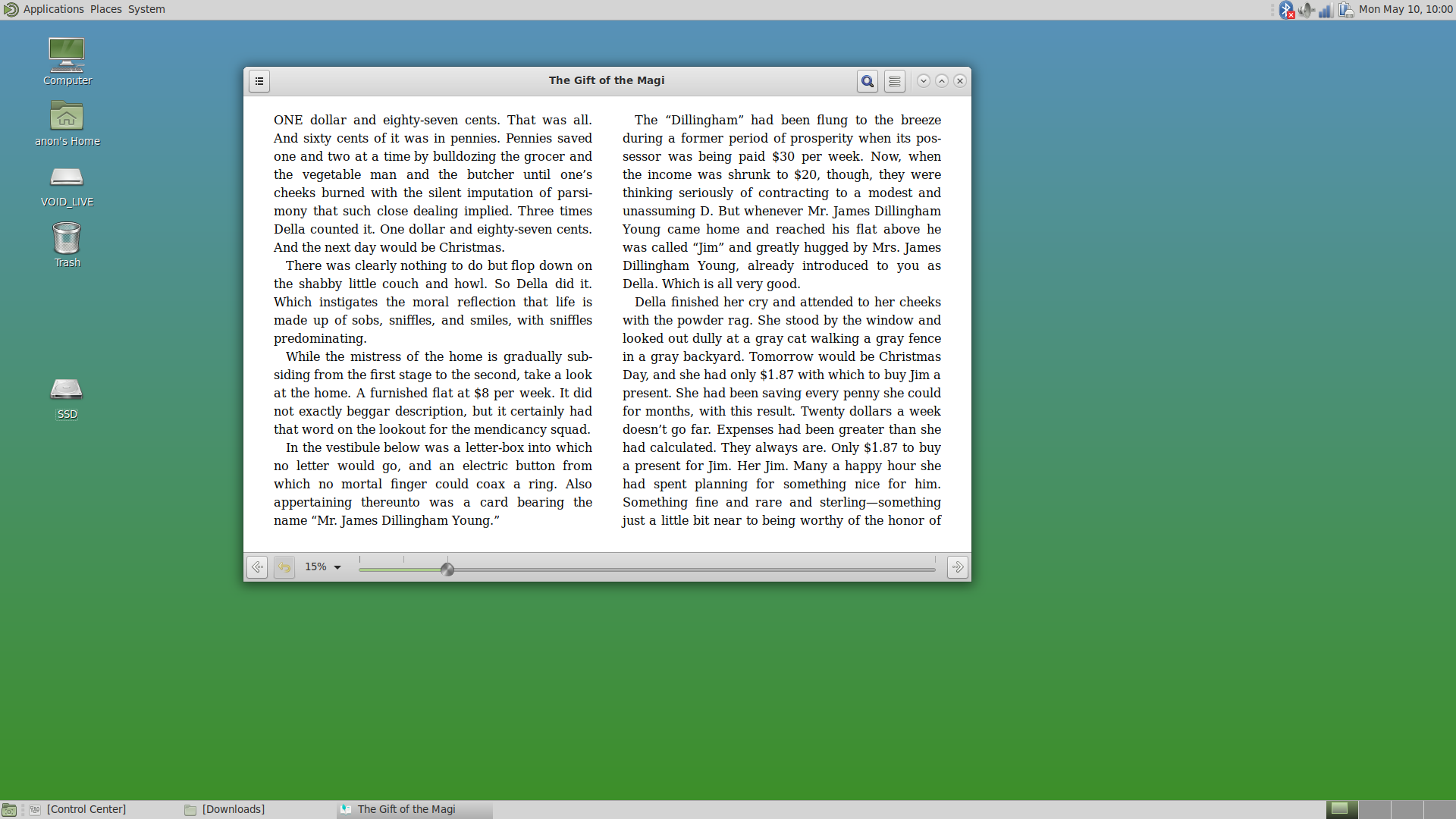
Foliate also exists in GeckoLinux rolling:
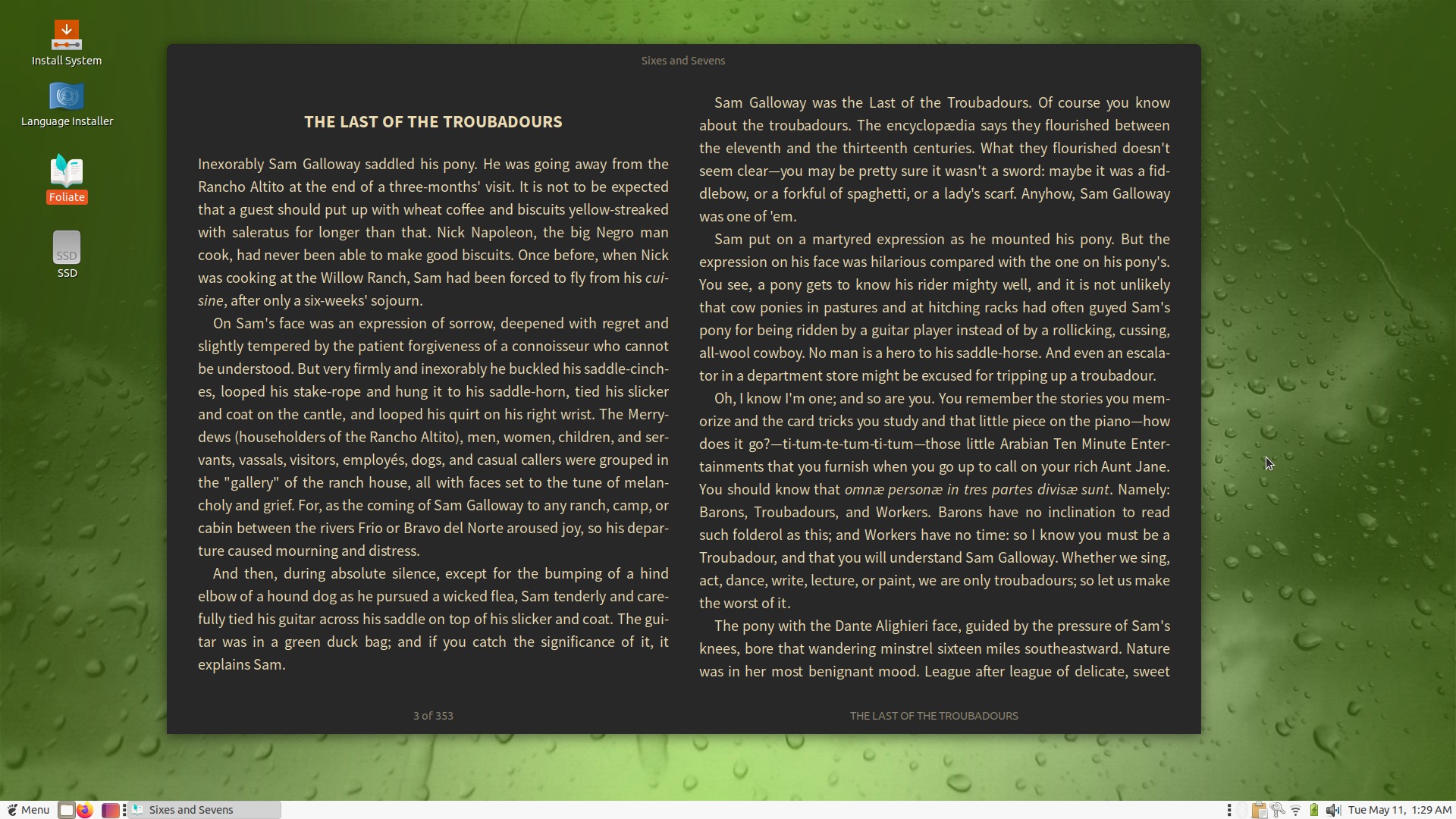
Here’s the catch though: GeckoLinux rolling, and by this I mean openSUSE Tumbleweed, is fucked up. I told YaST2 to install Foliate, and what it installed wasn’t enough to have Foliate running!
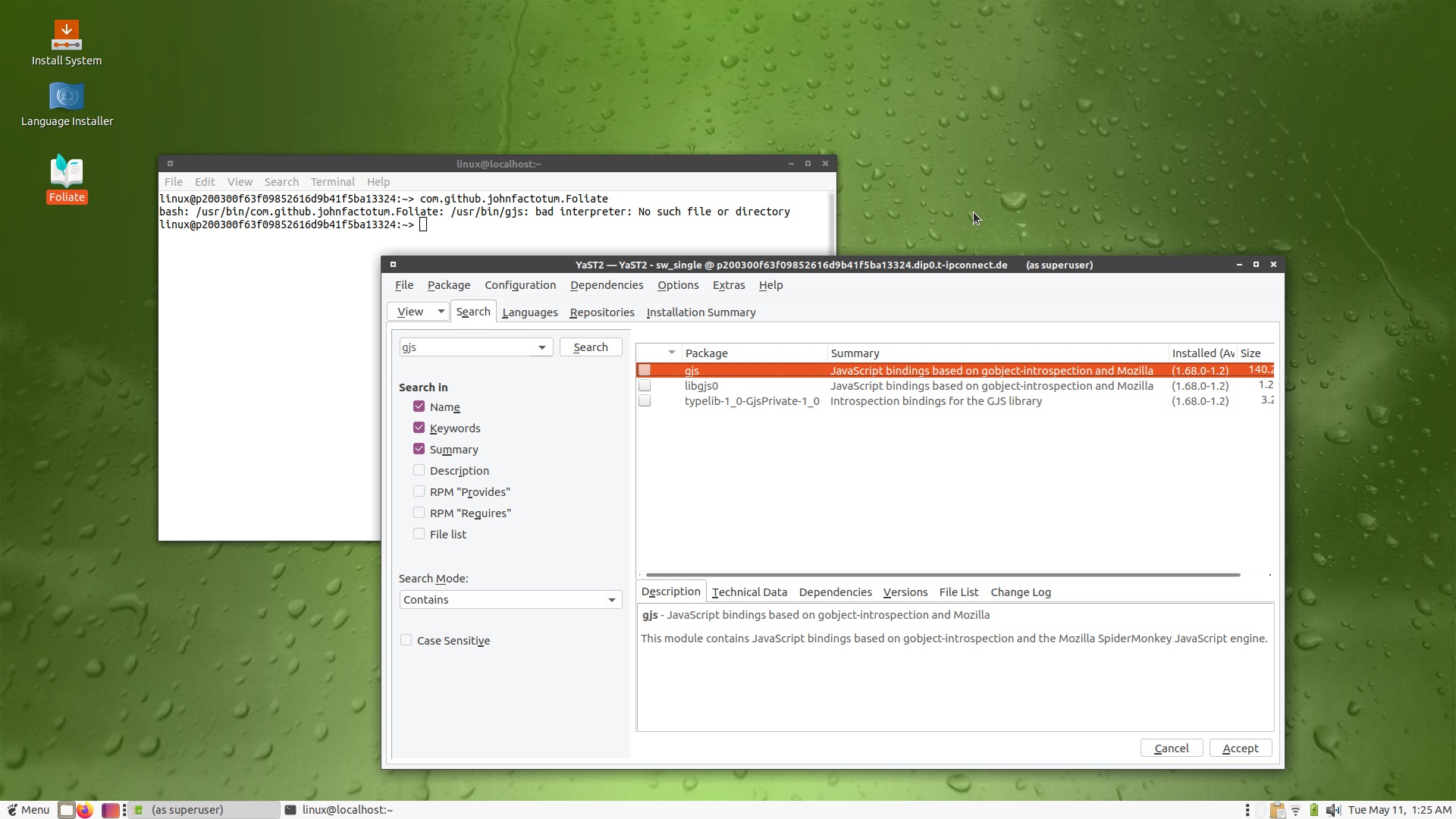
That means openSUSE Tumbleweed doesn’t have the package dependencies properly defined! Heck, if I have to manually install every dependency, why wouldn’t I use Slackware, or Linux From Scratch?
What bottom line then?
There’s no bottom line. I’m grumpy and oldish, but I liked better the Linux distros from 15-20 years ago. So many distros died, and we’re left with tons of crap. Only Windows 10 is worse. (Also, to me, macOS is useless and unusable.)
Of course I can add repos or PPAs (piece of cake in *buntu), and I usually find a way to get the desired applications without snaps and shit. But I’m so pissed off by the way things are these days!
Well, the lesser evil, they say. Between Windows 10 and Linux, Linux. Between GNOME and almost anything else, anything else. Between KDE and MATE, so far it’s MATE. Between Ubuntu MATE and Arch/SalientOS/ArcoLinux with MATE, so far it’s Ubuntu MATE. Time will tell whether I’m wrong or not.
As for the guys from Void Linux, they remind me of certain FreeBSD developers from about 15 years ago…

I take it all back!
Re-read a few times, and had a few chuckles with a less serious head on my shoulders!
I will be back, age permitting – I pick up UK state pension in June, so work it out…
Be safe.
Jim Acklaw
Bodhi linux actually makes me want to vomit. It may run good on low end pcs or laptops but it just looks bad really bad. I’ve tried using it and it just did not look like a professionally designed operating system. if the desktop environment could be changed to something else, anything else that would certainly help or a different theme, ANY theme would be better even if it looked like ms windows xp.
I just found your blog and have to agree with you about the Void Linux developers; they are a rude, unappreciative bunch.
I was trained by the US Air Force to support modified Unix systems and have been supporting Unix off and on since then. In late 1995, early 1996, I was introduced to FreeBSD and Slackware by a guy named J. Fulton with whom I worked. We used the Internet connection at work (with permission) to download the 1.44 floppy disk images for both and I chose to stay with Slackware, at the time.
Eventually, I ended up on S.u.S.E. and fell in love. For my PPC systems, I used Yellow Dog Linux. I’ve been using and supporting Linux for a long time.
In mid-2011, I had a brain aneurysm rupture and it was about 2 years (it may be longer, those years are fuzzy) before I could sit at a computer again. When I did log in to my openSUSE and SLED systems and update them, I had massive problems. I had no clue that systemd had rolled out almost over night and I certainly did not understand any of the arguments.
Something called ‘journald’ was keeping my system from booting and none of the commands I’d been using for a long time worked (e.g., ‘ifconfig’). When I went on the forums and asked for help, I was attacked by the pro-systemd side for daring to ask questions (those posts still exist). After several frustrating months, I began looking for other distros.
Fast forward to Juan RP and Void Linux. I love the openBSD philosophy and deploy it as a server; however, for desktop work and light gaming, it is horrible. I don’t remember how I found Void Linux, but I liked it… with a caveat. Every time I sought help, either in their forums (either self-hosted or Discus), the developers came off as asshats, with Juan RP being the worst.
When the fiasco about Juan leaving hit, I pulled Void off every production machine I had and put it on something else entirely, such as Ubuntu (for office desktop use in the Administration Office, as an example).
In mid-2022, I had updates installed on the machines and found out that they have a restricted file which automatically removes any package they deem to be unfit, for whatever reason. For my situation, they removed VeraCrypt and exfat-utils and fuse-exfat, as well as some other smaller dependencies. Once again, I reached out for help and was attacked, much like you experienced above.
A short story longer than it should be to say that I’ve been using Linux for ages, even having helped with language packs in office suites and stuff; however, Void Linux developers are their own special breed of hate and arrogance.
I have no idea what to use anymore. I hate systemd (bad experience at the beginning), GNOME 3.x+ (I don’t need my workflow dictated to me) and most modern OSes, in general. I’m currently downloading ISOs to see if I can find a distro for long-term use.
I tried Zorin and was impressed, which surprised me. Given my feelings about the foundation, I find that with a little tweaking, it’s rock solid stable and does what I need it to do; I’ve put about 10 people on Zorin and all of them love it (granted, they are Windows/Mac OS users). I remove snapd, completely kill tracker2/3, minimize my use of flatpak software and have had absolutely no trouble with the one or two games I play.
How about Fedora KDE Spin?
That’s the problem, for me, at least. I’m not excited about anything in the IT arena, lately. Fedora is tied to IBM/Red Hat, neither of whom I trust. To be fair, I don’t trust any companies; however, Fedora/Red Hat are like openSUSE and SLED used to be: tied at the hip to the company.
Also, I was put off by KDE back when it was a massive resource hog. I’ve tried it a couple times since then, but it takes so much tweaking to make it halfway usable that I end up installing another distro.
I did just download Nobara, both KDE and GNOME. Might give them a try tonight … I just need a working system *sigh*
The situation, as I see it, is as follows:
1. I used to be a huge fan of Xfce. Not anymore. One day I’ll write about why, but it has to do with Thunar and with the attitude of its maintainer.
2. Since I manipulate/manage a lot of files, and I need proficiency at that, I found out that Dolphin is the best file manager there is. Out of all, it’s also the only one to fix (in Qt) a bug that the Linux kernel has regarding exFAT! And yes, I use external exFAT drives (HDD, SSD) to backup books, comics, music, films.
3. Xfce isn’t as light as it used to be, and that’s because of GTK3. Meanwhile, KDE Plasma is increasingly usable, and you’d really want to use the latest KDE, because they constantly fix bugs, and also add some nice features! But bug-fixing is important. For the latest Plasma, one could have the choice of:
– the latest non-LTS Kubuntu + a PPA for the latest KDE: https://launchpad.net/~kubuntu-ppa/+archive/ubuntu/backports
– Manjaro or an Arch derivative such as EndeavourOS
– Fedora, which, while not being a rolling-release distro, gets the latest KDE (with a ~2-week delay) in the current point version (FC37 has KDE 5.27.3)
– openSUSE Tumbleweed, or GeckoLinux Rolling Plasma
4. Fedora being Red Hat and owned by IBM is something I don’t want to think about. Or openSUSE having been owned by Novell, then Attachmate, and now by EQT Partners. Being owned by a bunch of shitheads seems to be inevitable nowadays. Who knows, maybe Saudi Arabia or the Emirates will buy them all! Or maybe the Chinese…
5. I would advise against Nobara. They use a heavily-patched kernel, and I cannot trust that. They say it’s for games, but on my pure Intel miniPC, no Nvidia, no nothing, it feels slower. Heck, they even use their own patched Firefox, which is lagging behind (110.0-3.fc37 while Fedora has 111.0.1-1.fc37). Finally, they replaced SELinux with AppArmor. Too many changes that risk breaking your system.
6. So, while I’m now running Fedora KDE spin, I might consider going for openSUSE Tumbleweed. (I don’t like GeckoLinux’s customizations, and I can add repos myself.) I hate when I see abandoned packages, and Calibre (the e-book management app) is severely deprecated in FC37. It’s actually severely deprecated pretty much everywhere, as it’s a very dynamic app that updates frequently, and it seems it’s a PITA to package for a distro. To get the latest version of Calibre, these are the only ways:
– upstream binary, which means no package management and manual update (Calibre checks for updates every single time it’s launched!)
– Flathub
– Arch, Manjaro
– openSUSE Tumbleweed
For reference, FC37 has Calibre 5.43.0, which was released on May 27, 2022! The current version is 6.14.1, released on March 16, 2023. FC38 will have the same deprecated 5.43 (that’s what we have in Rawhide), because nobody bothered to build a newer version.
A newer Calibre requires
pyqtwebengine-devel6.x andpython3-qt6-webengine, but Fedora only haspyqtwebengine-devel5.x andpython3-qt5-webengine! Well, that’s the problem with Linux: when some app you care about, so you want its latest version, requires newer libraries than those provided by the OS, what do you do? Install a Flatpak? Install it for your user only, from upstream, when possible? That’s reminiscent of how Windows apps come with their own copies of Microsoft Visual C++ Redistributable DLLs, thus filling the filesystem with countless copies of the same libraries, just in different versions.I shouldn’t care much, as updating Calibre is easy (
sudo -v && wget -nv -O- https://download.calibre-ebook.com/linux-installer.sh | sudo sh /dev/stdin), but not having the proper Python bindings for Qt6 in Fedora is absolutely unthinkable! (Well, there ispython3-pyqt6, but apparently this isn’t enough, as it doesn’t cover WebEngine.)